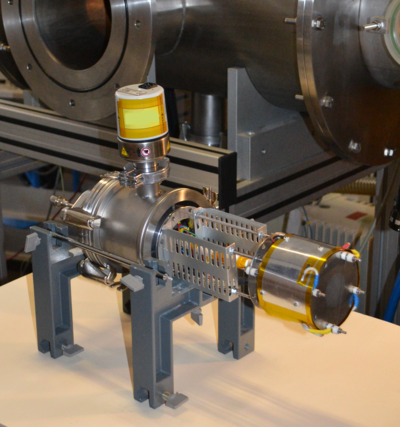Named as ALPHIE (Alternative Low Power Hybrid Ion Engine), this ion thruster has been developed in the Plasma Laboratory of the Department of Applied Physics to the Aeronautical and Naval Engineering of the School of Aeronautical and Space Engineering (Escuela Técnica Superior de Ingeniería Aeronáutica y del Espacio, ETSIAE) at the Universidad Politécnica de Madrid (UPM).
Electric propulsion allows significant cost reductions and it is a key to developing commercial applications using low-orbit satellites between 200 and 2,000 km above the Earth's surface (Low Earth Orbit, LEO). The driving force is obtained through a source of electrical energy which accelerates charged particles (ions) at speeds much higher than those available to traditional spacecraft engines.

ALPHIE (Alternative Low Power Hybrid Ion Engine) Laboratory Prototype
The originality of ALPHIE, developed by the group led by Professor Luis Conde, resides in the fact that its new technology is simpler and more efficient than other models. This thruster is the result of several projects on the physics of ion and electron (plasma) flows acceleration at high speeds in which the UPM group has been working for the last six years through different public calls for proposals and also in collaboration with the Spanish multinational Aernnova Aerospace.

Both parties are jointly committed to introducing this innovative plasma engine, developed by UPM researchers through a joint ownership and exploitation contract, into the minisatellite market. The first step has been filing a patent application, which has just been granted by the United States Patent and Trademark Office and it is currently being processed by the European Patent Office, which likely will also positively conclude in the coming months.
Commercial application of satellite constellations
Services such as interactive television, autonomous cars or internet access for ships on the high seas require a high quality connection with a global coverage. This objective can only be efficiently and economically achieved through constellations of small satellites orbiting the Earth. Examples of these commercial projects are OneWeb, O3b or Starlink from SpaceX, which are deploying groups of satellites reaching 1,000 units.

To provide service for clients on the Earth's surface, the aforementioned satellites should describe precise low-orbit trajectories, operating in a simultaneous way and networked. However, sometimes their orbits experience deviations, breaking their formation and consequently, interrupting the data traffic.
“ALPHIE would serve to make the necessary corrections to adjust their orbit and maintain training and it would do it with greater efficiency than other models in today's market," explains UPM professor Luis Conde. “In addition, this propulsion system would also be useful to expel these vehicles from their trajectory at the end of their useful life and thus controlling the increase in space debris in Earth orbit," he concludes.

